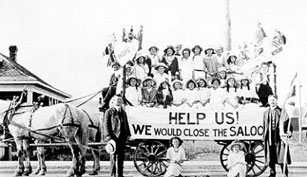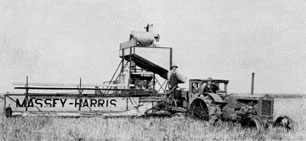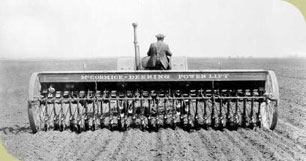|
FESTUS
CHAPIN, HIS FAMILY and Mr. E.W. Bateman came to Hartney in 1892 from
Portage la Prairie, where Chapin and Bateman were business partners. In
Hartney they built a two-storey brick building, now the Municipal
Office. The Chapin family lived above the office and warehouse, while
Bateman built a house on the corner of West Railway and William.
These partners opened Hartney’s second lumber yard, built another
30,000 bushel grain elevator and hired David McCulloch of Souris to
operate it. In 1894 Mr. Chapin took over the Hartney business
completely and Bateman returned to Portage to carry on business there.
In the activities of the town, before and after its incorporation, Mr.
Chapin took part. He was a member of the town council when the town
hall was built and opposed his view to those of the other council
members in a spirited debate that overflowed from the council chamber
to the pages of The Hartney Star.
Mr. Chapin was a stout Baptist and, with J.L. Graham and the Turnbull
brothers, did a great deal to promote the establishment of a Baptist
church in the town. In 1903 he was appointed to the board of Brandon
College and served four years. He was keenly interested in the
temperance movement and threw his influence into the defeat of all
attempts to sell liquor in Hartney. He was working for the
establishment of a temperance hotel when he died suddenly in 1907.
Adapted from The Mere
Living, page 102.
The
Temperance Advocate
In the latter years of the 19th century and the first decades of the
20th, temperance and prohibition were prominent issues on the social
and political stage. The temperance movement found adherents across the
political spectrum, from Social Gospellers like J.S. Woodsworth
(founder of the CCF, later NDP) to middle class reformers like the
Women’s Christian Temperance Union (W.C.T.U.).
Prohibition has a long and complicated history in Manitoba, beginning
with provincial referenda in 1893 and 1898. These plebiscites were not
enforced, and even in the 1901 election, where public sentiment was
strongly in favour of prohibition, the government did not enforce the
Prohibition Act. The crisis of the First World War was a turning point
for the temperance movement. Public opinion was firmly behind them, and
prohibition was passed in 1916 by the Liberal Government of T.C. Norris.
A majority of the temperance crusaders were women, and the history of
the temperance movement is inextricably linked with the history of the
suffrage movement. Temperance was infused with the message of the
Social Gospel, but is was also compatible with the ideologies of
maternal feminism. Urban women saw the linkages between poverty and
alcoholism, while many rural women were aware of how the isolation of
farm life amplified the horrors of alcohol abuse. Embracing sobriety as
a solution to what they perceived as the moral decay of their society,
temperance activists increasingly abandoned persuasion and education to
lobby for the outright ban of the sale of alcohol.
Blaming alcohol for social ills was a safe and comfortable option since
it did not threaten the middle class way of life or call for any
dramatic social changes. Reformers linked alcohol with poverty, mental
illness and crime, and they associated it with the ills of urbanization
and immigration. Most temperance crusaders were of the middle classes,
and a large number of these were Protestant. Prohibition required the
passage of legislation, and thus the link between temperance and
suffrage developed. The W.C.T.U was all but incorporated into the
Political Equality League in the years from 1914 to 1916.
From MHS on-line

Sunday School Group, Calgary, 1912.
Implement
Dealers
Festus Chapin’s business as an implement dealer was a key one in
Hartney, and one that many other individuals also attempted over the
years. All would have been very familiar with all lines of farm
machinery, and of the firms that manufactured them.
Prior to 1900, all manufacturing consisted of short-line companies:
full-line companies emerged primarily as a means to overcome
competition. International Harvester Company (IHC), for instance, was
formed in 1902 as an amalgamation of the five largest existing
manufacturers of harvest equipment at the time.
Canada had two full-line companies: Massey-Harris (later to become
Massey-Harris-Ferguson, and finally Massey-Ferguson) and Cockshutt,
both located in the Hamilton region of Ontario. The Massey Company at
one time was the world’s largest manufacturer of farm equipment;
however, it fell on hard times and went into receivership in 1988.
It is important to make the connection between the blacksmith shop and
farm equipment manufacture, as it has often been said that the
innovations and progressive ideas for machinery improvements largely
came from farmers.

Perry and Edna Cowan and Nellie Carter in 1928.
Key Farm Implements at 1900
Gang Plow – a combination of two or more plows in one frame
Harrow – implement for breaking up soil
Broadcast Seeder – used for spreading seed
Swather – machine to cut hay and cereal crops
Thresher – machine used to separate grain from stalks and husks
Wagons
All of these pieces of machinery were typically drawn by horses and
eventually tractors.
The
Massey-Harris Company
The firm was founded in 1847 in Newcastle, Ontario by Daniel Massey as
the Newcastle Foundry and Machine Manufactory. The company began making
some of the world's first mechanical threshers, first by assembling
parts from the United States and eventually designing and building
their own equipment. The firm was taken over and expanded by Daniel's
eldest son Hart Massey who renamed it the Massey Manufacturing Co. and
in 1879 moved the company to Toronto where it soon became one of the
city's leading employers. The massive collection of factories,
consisting of a 4.4 hectare (11 acre) site with plant and head office
at 915 King Street West, became one of the best known features of the
city. Massey expanded the company and began to sell its products
internationally. Through extensive advertising campaigns he made it one
of the most well known brands in Canada..
In 1891, Massey merged with the A. Harris, Son & Co. Ltd. to become
Massey-Harris Co. and became the largest agricultural equipment maker
in the British Empire. The company made threshing machines and reapers
as well as safety bicycles, introducing a shaft-driven model in
1898.[2] In 1910, the company acquired the Johnson Harvester Company
located in Batavia, New York, making it one of Canada's first
multinational firms.

A disc seeder in operation.
|





